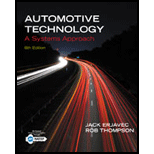
Automotive Technology: A Systems Approach (MindTap Course List)
6th Edition
ISBN: 9781133612315
Author: Jack Erjavec, Rob Thompson
Publisher: Cengage Learning
expand_more
expand_more
format_list_bulleted
Concept explainers
Textbook Question
Chapter 9, Problem 10ASRQ
Technician A says that if an engine had good results from a compression test, it will have good results from a cylinder leakage test Technician B says that if an engine had good results from a cylinder leakage test, it will have good results from a running compression test Who is correct?
- Technician A
- Technician B
- Both A and B
- Neither A nor B
Expert Solution & Answer
Want to see the full answer?
Check out a sample textbook solution
Students have asked these similar questions
The gas/oil mixture used in a two stroke engine has been properly mixed. The carburetor high speed & cruise circuit is adjusted to lean. Tech a says that the lean adjustment may cause the engine to fail due to improper lubrication: tech b says that it may cause the engine to fail because of overheating. Who is correct?
A six-cylinder engine has a 1 5 3 6 2 4 firing order. Technician A says that after cylinder number 1 begins its intake stroke, the crankshaft will have to travel 240° before cylinder number 3 begins its intake stoke. Technician B says that when cylinder number 3 and 4 are at TDC, cylinders number 5 and 2 are at BDC.
Who is correct and explain why?
Technician A
Technician B
Both A and B
Neither A nor B
Carbon deposits on the intake valve or seat may cause the valve not to close properly. Tech a says that the flywheel will be harder to spin when starting the engine. Tech b says that the engine will loose power. Who is correct?
Chapter 9 Solutions
Automotive Technology: A Systems Approach (MindTap Course List)
Ch. 9 - Prob. 1RQCh. 9 - Describe what takes place during the four strokes...Ch. 9 - As an engines compression ratio increases, what...Ch. 9 - What test can be performed to check the efficiency...Ch. 9 - Describe tappet noise.Ch. 9 - Which of the following statements about engines is...Ch. 9 - Which stroke in the four-stroke cycle begins as...Ch. 9 - True or False? In an HCCI engine, combustion...Ch. 9 - Which of the following is not a true statement...Ch. 9 - True or False? SAE mandates that engine, when...
Ch. 9 - Technician A says head gasket thickness has an...Ch. 9 - Prob. 12RQCh. 9 - The stroke of an engine is the crank throw half...Ch. 9 - True or False? The camshaft is always located in...Ch. 9 - Which of the following is an expression of how...Ch. 9 - While diagnosing the cause for blue smoke from the...Ch. 9 - Prob. 2ASRQCh. 9 - While determining the cause for air leaking out of...Ch. 9 - While diagnosing the cause for an engine having...Ch. 9 - While looking at the results of an oil pressure...Ch. 9 - A vehicle is producing a sharp, metallic rapping...Ch. 9 - While conducting an engine vacuum test; Technician...Ch. 9 - While determining the most likely problem of an...Ch. 9 - When a customer states that black exhaust smoke is...Ch. 9 - Technician A says that if an engine had good...
Knowledge Booster
Learn more about
Need a deep-dive on the concept behind this application? Look no further. Learn more about this topic, mechanical-engineering and related others by exploring similar questions and additional content below.Similar questions
- While determining the most likely problem of an engine with poor compression test results but acceptable cylinder leakage readings: Technician A says that the problem may be incorrect valve timing. Technician B says that the problem is worn valve seats. Who is correct? Technician A Technician B Both A and B Neither A nor Barrow_forwardWhile diagnosing the cause for an engine having good results from a compression test and cylinder leakage test but poor results from a cylinder power balance test: Technician A says that incorrect valve timing is the most likely cause. Technician B says that a severely worn cam lobe is a likely cause. Who is correct? Technician A Technician B Both A and B Neither A nor Barrow_forwardWhile determining the cause for air leaking out of the oil throttle body during a cylinder leakage test: Technician A says that a burnt intake valve is indicated. Technician B says that a warped cylinder head or bad head gasket is indicated. Who is correct? Technician A Technician B Both A and B d. Neither A nor Barrow_forward
- Technician A says an engine may use one or more valve springs per valve. Technician B says additional valve springs are used to control vibration and increase total pressure. Who is correct? a. Technician A b. Technician B c. Both A and B d. Neither A nor Barrow_forwardWhile discussing the causes of extreme engine bearing damage Technician A says that contaminated and old engine oil could be the cause. Technician B says that a leaking radiator could be the cause. Who is correct? Technician A Technician B Both A and B Neither A nor Barrow_forwardWhich of the following statements is incorrect? Cylinder head bolts must be tightened to the proper amount of torque. Most cylinder head bolts are tightened in a sequence that starts on one end. On some engines, the head bolts are retorqued after the engine has been run and is hot. Many engines use head bolts of different lengths.arrow_forward
- Which of the following are not typically found in the block of a modern engine? a. Pistons b. Crankshaft c. Valves d. Oil pumparrow_forwardWhile discussing the common causes for cracks developing in a cylinder block or head: Technician A says that the chilling of a hot engine by a sudden rush of cold water or air over the surf ace may cause cracking. Technician B says that excessive overheating is a common cause. Who is correct? Technician A Technician B Both A and B Neither A nor Barrow_forwardWhile diagnosing an engine that overheats after frequent hard accelerations: Technician A checks for a collapsed lower radiator hose. Technician B checks the cooling fan electrical circuit. Who is correct? Technician A Technician B Both A and B Neither A nor Barrow_forward
- While discussing the reasons for resurfacing a cylinder head; Technician A says it should be resurfaced to make it flat and very smooth so the head gasket can seal properly during engine assembly. Technician B says that it can be resurfaced to raise the compression. Who is correct? Technician A Technician B Both A and B Neither A nor Barrow_forwardWhen conducting an oil pressure test: Technician A says that lower than normal pressure can be caused by faulty piston oil rings. Technician B says that lower than normal oil pressure can be caused by excessive engine bearing clearances. Who is correct? Technician A Both A and B Technician B Neither A nor Barrow_forwardWhile looking at the results of an oil pressure test: Technician A says that higher than normal readings can be caused by using oil that is too thin. Technician B says that higher than normal readings can be expected on a cold engine. Who is correct? Technician A Technician Both A and B Neither A nor Barrow_forward
arrow_back_ios
SEE MORE QUESTIONS
arrow_forward_ios
Recommended textbooks for you
 Automotive Technology: A Systems Approach (MindTa...Mechanical EngineeringISBN:9781133612315Author:Jack Erjavec, Rob ThompsonPublisher:Cengage Learning
Automotive Technology: A Systems Approach (MindTa...Mechanical EngineeringISBN:9781133612315Author:Jack Erjavec, Rob ThompsonPublisher:Cengage Learning Automotive TechnologyMechanical EngineeringISBN:9781337794213Author:ERJAVEC, Jack.Publisher:Cengage,
Automotive TechnologyMechanical EngineeringISBN:9781337794213Author:ERJAVEC, Jack.Publisher:Cengage,

Automotive Technology: A Systems Approach (MindTa...
Mechanical Engineering
ISBN:9781133612315
Author:Jack Erjavec, Rob Thompson
Publisher:Cengage Learning

Automotive Technology
Mechanical Engineering
ISBN:9781337794213
Author:ERJAVEC, Jack.
Publisher:Cengage,
8.01x - Lect 27 - Fluid Mechanics, Hydrostatics, Pascal's Principle, Atmosph. Pressure; Author: Lectures by Walter Lewin. They will make you ♥ Physics.;https://www.youtube.com/watch?v=O_HQklhIlwQ;License: Standard YouTube License, CC-BY
Dynamics of Fluid Flow - Introduction; Author: Tutorials Point (India) Ltd.;https://www.youtube.com/watch?v=djx9jlkYAt4;License: Standard Youtube License